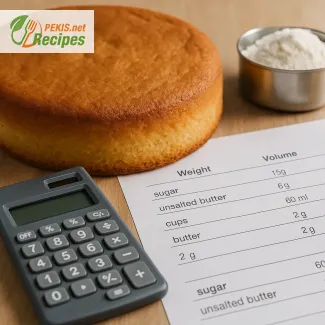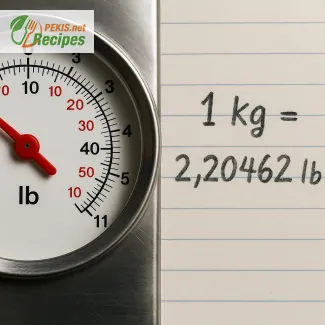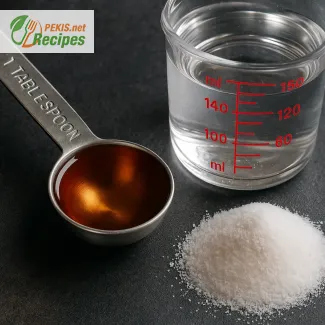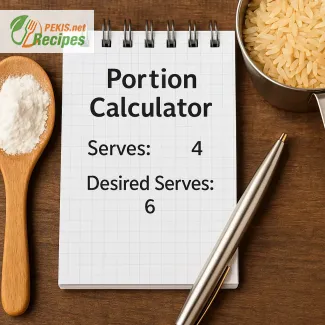
Scale Your Cake Recipes with Precision and Confidence
The smartest way to convert cake quantities for any baking pan or portion size
Converting cake recipes accurately is one of the most common and frustrating tasks for home bakers and professionals alike. Whether you're adjusting a cake recipe to fit a different size pan, scaling up for a party, or modifying for fewer servings, it's crucial that your ingredients stay in perfect proportion. That's where a cake converter calculator comes into play—providing a reliable, mathematical solution to a creative process.
This article is your complete guide to using a cake converter tool effectively. Learn how to adapt measurements by weight, volume, and pan dimensions while maintaining taste and texture. Discover tips on conversions, common mistakes, and practical examples so you can bake with precision every time.
🎂 Cake Size Converter
Why cake recipe conversion matters
Cake recipes rely on precise ingredient ratios for structure, moisture, and flavor. Unlike savory dishes where amounts are flexible, even a small deviation in a baking formula can result in a dense, dry, or collapsed cake. That’s why using a reliable method to scale cake recipes by weight and volume is essential.
You might need to convert a cake recipe for several reasons:
- You want to bake a half batch or double batch of your favorite sponge.
- Your pan size is different from the one specified in the recipe.
- You're baking for a specific number of guests or individual servings.
- You only have certain ingredients available and need to adapt based on what's in your pantry.
Whatever the reason, the cake converter calculator helps you recalculate your recipe with confidence.
How the cake converter calculator works
A typical cake converter uses one or more of the following inputs to scale a recipe:
- Original cake pan dimensions (e.g., 9-inch round, 20x30 cm rectangular)
- Target cake pan size or portion count
- Original ingredient amounts in weight (grams) or volume (ml)
- Desired scaling factor (e.g., 1.5x, 0.75x)
The calculator uses geometric formulas and ingredient ratios to determine exactly how much of each ingredient is needed. This avoids the guesswork and ensures consistent baking results.
Most advanced calculators offer:
- Weight-based conversions for precision (grams, ounces)
- Volume-based conversions (ml, cups, tablespoons)
- Portion-based scaling (e.g., from 8 to 12 slices)
- Automatic adjustment for baking time and temperature suggestions based on pan depth and volume
When to scale by weight vs. volume
Understanding when to use weight measurements versus volume measurements is key for accurate conversions.
Weight-based scaling
Scaling by weight is the most accurate method, especially for dry ingredients like flour and sugar or dense liquids like butter and yogurt. This approach ensures consistency regardless of humidity, packing, or measuring tools.
Use weight if:
- You're working with metric recipes (grams or ounces)
- Precision is essential (e.g., professional baking)
- Ingredients vary in density (e.g., brown sugar vs. white sugar)
Volume-based scaling
Volume scaling is common in home kitchens, especially for liquid ingredients. Cups, tablespoons, and teaspoons are standard in many English-speaking recipes.
Use volume if:
- The original recipe uses cups or ml
- You're scaling small batches
- You don’t have a kitchen scale available
However, always remember: flour 250 ml ≠ sugar 250 ml ≠ butter 250 ml. These ingredients have different densities, so volume conversion must take that into account.
Scaling cakes for different pan sizes
Changing pan size is one of the most frequent reasons to use a converter. A cake meant for a 20 cm round pan will behave differently in a 23 cm square pan, especially in baking time and height.
Adjusting for shape and volume
Use the following steps:
- Calculate the volume of both the original and new pan (for round: π × r² × height; for square/rectangular: length × width × height)
- Determine the ratio (new volume ÷ original volume)
- Multiply each ingredient by that ratio
If your original pan is 1,200 ml and your new one is 1,800 ml, the scaling ratio is 1.5. Multiply each ingredient by 1.5.
Adjusting baking time
- Larger pans: Cake may bake faster due to more surface area.
- Deeper pans: May require lower temperature and longer baking time.
- Rule of thumb: reduce temperature by 10–15°C (25°F) for deeper pans and extend baking time by 10–25%.
Scaling recipes for servings or portions
Sometimes, it’s not about the pan—it’s about how many people you're serving.
If a recipe makes 8 servings and you need 12, multiply all ingredients by 1.5. The same logic applies to individual portions like cupcakes or mini cakes.
Tip: Don’t forget to adjust frosting or filling amounts too. Those can be even more volume-sensitive than the cake itself.
Common cake types and their density impact on scaling
The type of cake you’re baking affects how it scales. A dense pound cake behaves differently from a light chiffon or sponge cake. Here’s how density influences volume and height in a new pan:
- Light sponge cakes: Expand more, require lower fill levels (60–70% of pan)
- Butter or pound cakes: Denser, rise less, can fill pan up to 75–80%
- Mousse or no-bake cakes: Usually require exact volume matching and refrigeration time adjustment
Understanding the cake’s structure helps you avoid overflow, sinking, or underbaking.
Practical examples of cake conversions
Let’s explore real-world examples to show how a cake converter makes baking easier:
Example 1: Convert from 23 cm round pan to 20 cm square
- 23 cm round volume ≈ 4,150 ml
- 20 cm square volume ≈ 4,000 ml
- Ratio ≈ 0.96
- Multiply all ingredients by 0.96 (very minor adjustment)
Example 2: Doubling a chocolate cake recipe
Original for 8 servings → Want 16 servings → Multiply by 2.0
Check that the new amount fits into your available pans (volume check!) and adjust baking time accordingly.
Example 3: Half batch of carrot cake
Original 30x40 cm tray recipe → Want 15x20 cm → Area is 1/4, but thickness same → Scale by 0.5 if you want to preserve height and texture.
Tips for successful cake scaling
- Don’t forget eggs: Always round up/down carefully; splitting eggs may require using weights.
- Baking soda & powder: Proportionally reduce; don't over-leaven or cake may collapse.
- Flavoring agents: Vanilla, citrus zest, spices should scale—but taste is subjective. Consider adjusting to preference.
- Frostings & fillings: Often need more than expected. Always prepare extra, especially for layered cakes.
- Use kitchen scale: A must-have for accurate results.
Tools to simplify conversions
While manual math is possible, most home bakers prefer tools to handle the conversion instantly.
Popular solutions:
- Online cake converter calculator (weight/volume/portions)
- Pan volume comparison charts
- Ingredient density tables (for converting volume to weight)
- Smartphone apps with pan size calculators and scaling ratios
These tools speed up the process and help you avoid mistakes when recalculating ingredient amounts.
Converting international measurements
Baking across regions often means converting units, such as:
- Grams ↔ Cups
- Milliliters ↔ Tablespoons
- Celsius ↔ Fahrenheit
- Centimeters ↔ Inches
Be aware that 1 cup of flour weighs 120–130 g, depending on how it's scooped or sifted. That’s why weight is more consistent.
Also consider ingredient differences:
- US butter sticks are 113 g each
- European butter typically sold in 250 g blocks
- All-purpose flour ≠ exact same across countries (protein % varies)
A good cake converter can account for these regional variations.
Mistakes to avoid when scaling cake recipes
Even experienced bakers make errors when adjusting recipes. Watch out for these:
- Forgetting to adjust baking temperature/time
- Not measuring baking powder proportionately
- Overfilling the pan (leads to overflow and burning)
- Changing pan shape without adjusting ratio
- Doubling or halving recipes with eggs without precise weights
When in doubt, test the new version before preparing for special occasions.
Storing and freezing scaled cake batter
You might wonder: can I prepare extra batter and store it?
- Chiffon/sponge batters: best baked immediately
- Butter-based batters: can rest up to 1 hour refrigerated
- Freezing: Not recommended for batters; better to bake and freeze cakes instead
- If you bake a larger quantity, store cooled cakes tightly wrapped at room temperature (1–2 days) or freeze up to 3 months
Scaling works best when you adjust for serving time, storage plans, and ingredient freshness.
Who benefits most from a cake converter calculator?
This tool is useful for:
- Home bakers adapting old family recipes to new pans
- Food bloggers offering different portion options to readers
- Catering professionals scaling up for weddings or events
- Beginner bakers needing structure and clarity in quantities
In short, anyone who wants to bake with confidence and consistency benefits from accurate recipe conversions.
Simplifying cake conversions
Using a cake converter isn’t just about numbers—it’s about making baking more joyful and stress-free. Whether you’re reducing a recipe for a small celebration or increasing it for a full-scale event, having a precise converter calculator is one of the best tools in your baking arsenal.
By understanding pan sizes, volume ratios, and ingredient behavior, you'll be able to approach any recipe with confidence and precision—without the guesswork.


